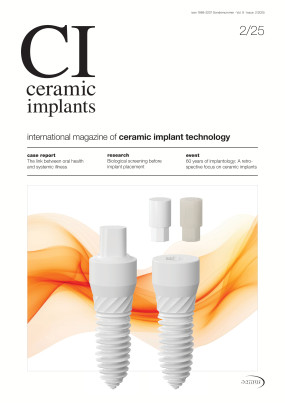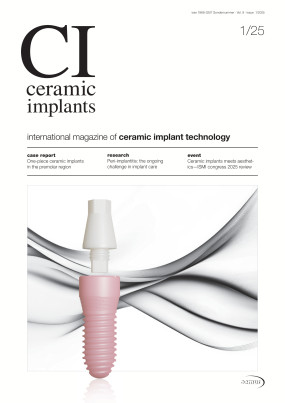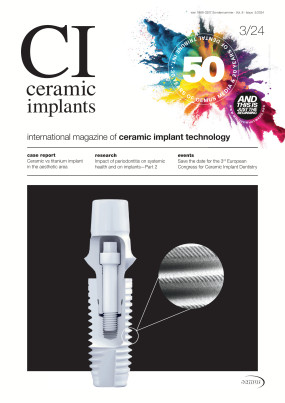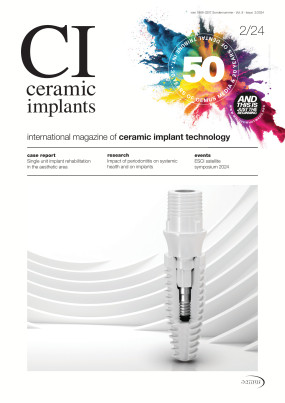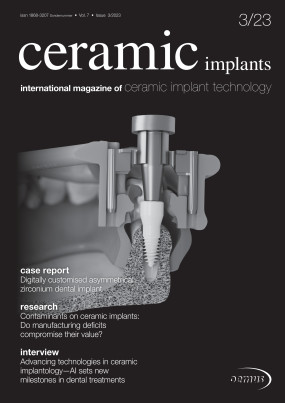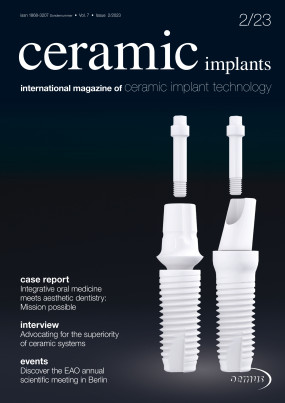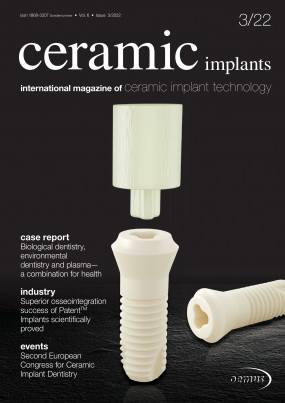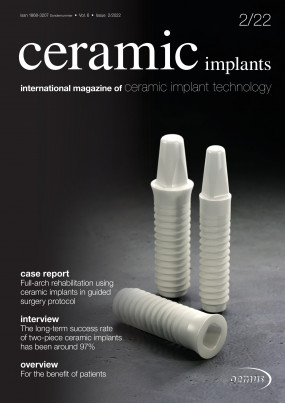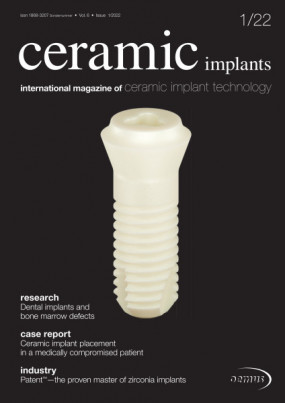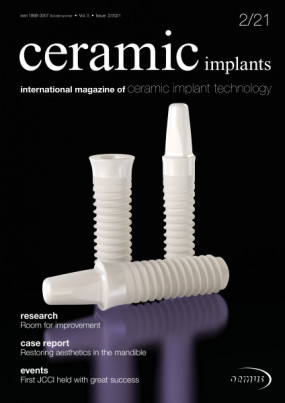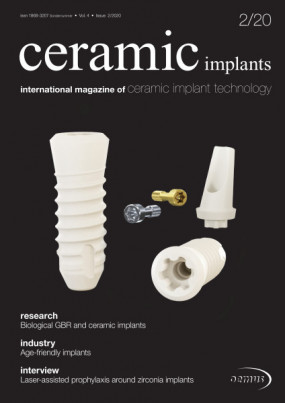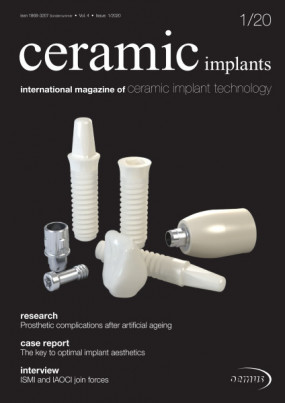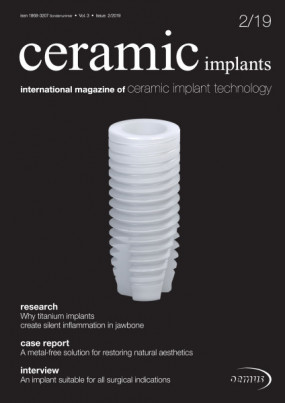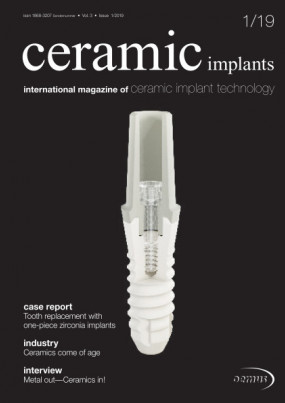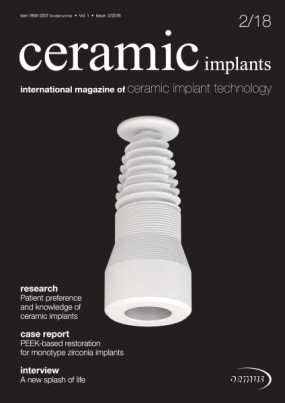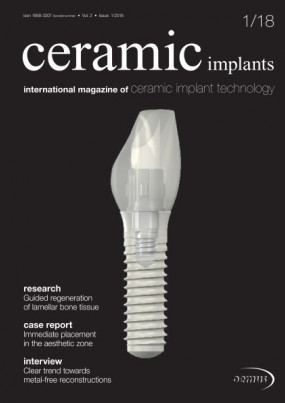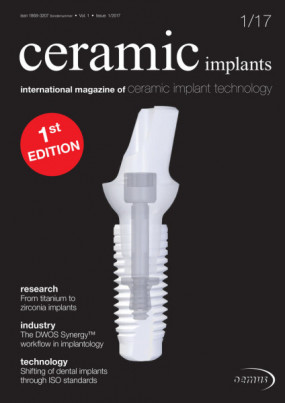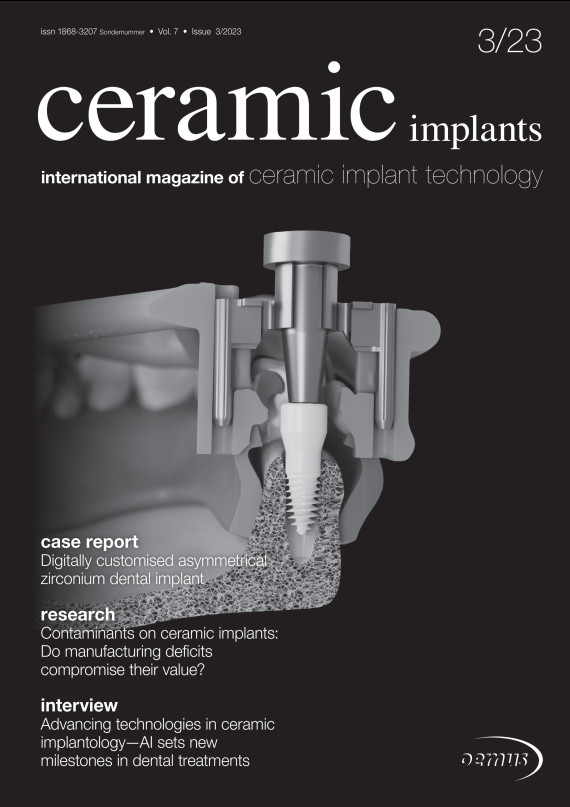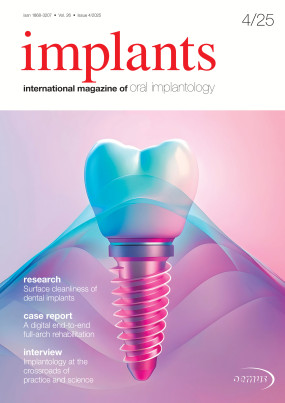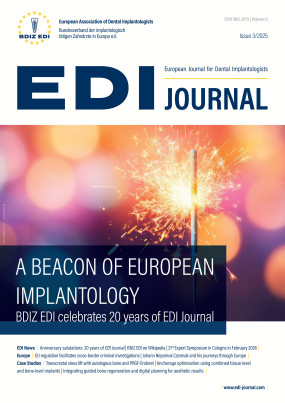Inhaltsverzeichnis
3
These days are full of change—socially, economically, biologically, and ecologically. The world is not the same anymore. What will future bring, what will be left behind? Many questions—who has the answers? Please let these thoughts buzz in the room. In this issue of ceramic implants, I would like to invite you to read the printed content with pleasure and with humility. Please let us all consider ourselves privileged—we got the opportunity to visit school, graduate from university and pursue our professions. Some of you are dedicated to research, others to practice. There is one thing we have in common: we have the same goal—we want to make a difference. We participate in our networks and in our exchanges—in what we read, in what we discuss at conferences...
4
5
Digitally customised asymmetrical zirconium dental implant—Replacement of a mandibular molar—Surgical and prosthetic aspects
Dr Dumitru Gogarnoiu, Jonathan Korostoff, DMD, PhD, Rodolfo Gianserra & Melania Gogarnoiu, DMD, USA & Italy
To reduce the overall treatment time required for replacement of a tooth with an implant-supported crown, clinicians will place the fixture immediately after an extraction. Under appropriate circumstances, especially in the anterior aspects of the jaws, this approach yields highly predictable functional and aesthetic results. In the posterior areas of the jaws, the anatomy of roots often compro- mises the available volume of bone to the extent that it is not possible to achieve primary stability of an immediately placed implant. To circumvent this issue, a customised two-piece implant system was designed in which the shape of the intraosseous component corresponds to the actual anatomy of the extracted tooth. The case re- port describes the implant and illustrates how it can be immediately placed following extraction of a mandibular molar that had a hopeless prognosis...
12
Full-arch: Full rehabilitation of the upper jaw—Part 1
Dr Dr Michael Rak, Norbert Wichnalek, Arbnor Saraci & Lukas Wichnalek, Germany
The complete rehabilitation of a compromised residual dentition is a great challenge both implantologically, functionally and aesthetically. Especially the demand for fixed dentures with their aesthetically and functionally satisfactory implementation is high. In addition, there is a growing interest among patients for biocompatible dentures and surgical concepts that take biological criteria into ac- count. Biological dentistry with metal-free implants and dental prostheses made of zirconium oxide can meet this demand at a high level. In the first part of the article, the authors discuss the assessment of the patient’s condition, the preparation of the patient and the surgical procedure of extracting the remaining teeth as well as the immediate insertion of the implants. The second part describes the prosthetic restoration of the patient...
20
Zirconia implants: New treatment option for the partially edentulous posterior mandible
Dr Phongphan Chinnahathaiwat, Thailand
Zirconia implants have become firmly established in implant dentistry. Patient demand for metal-free solutions is increasing, and the development of new biomaterials, micro-rough surface techniques and improved treatment protocols has enabled practices to use zirconia dental implants as a reliable treatment alternative to titanium dental implants. Multiple studies have demonstrated that zirconia implants cause little to no inflammation of the peri-implant soft tissue and allow for a high degree of epithelial attachment. In addition, these implants have a more natural look, and therefore provide better aesthetics...
24
Ceramic dental implants have long ceased to be hype, on the contrary, they can offer a significant addition to the daily dental implant practice. Not only their favourable aesthetics play a significant role, but also their ability to work completely metal-free is of added value, surely for patients with a proven allergy for grade 5 titanium, containing the hyperreactive components vanadium and aluminium...
30
Contaminants on ceramic implants: Do manufacturing deficits compromise their value?
Ken Serota, DDS, MMSc, USA
With new developments in biomaterials science and industrial technology, the profession has recognised that the long-term success of zirconium dioxide implants is demonstrably comparable to that of titanium. However, despite best manufacturing and packaging practices, the presence of contaminants and pollutants at the bone-implant interface of any implant material can initiate an in- flammatory response with consequential bone resorption. There is a pressing need for the industry to recognise the inherent value of screening dental implant devices for these toxic compounds to obviate the bio-interface reactions they can cause in the early phase of osseointegration (Figs. 1 & 2)...
32
First long-term study on two-piece zirconia implants published—No peri-implantitis after nine years of implant function
Author
The first long-term study on two-piece zirconia dental implants has been published—in Clinical Oral Implants Re- search—closing a major research gap.1 Over a period of nine years, the independent study, conducted at Heinrich Heine University Düsseldorf in Germany, examined inte- grated implants of the Patent™ brand (Zircon Medical) placed in the posterior region, which is subjected to higher occlusal loads.1 The research team, led by Prof. Jürgen Becker, who is director of the Department of Oral Surgery, concluded that the Patent™ Dental Implant System pro- vides a predictable and long-term tooth replacement solution, as it was able to maintain healthy and stable hard and soft tissue over the nine years of follow-up...
34
Advancing technologies in ceramic implantology—AI sets new milestones in dental treatments
An Interview with Dr Shepard DeLong, Lotus Dental Wellness, USA
Artificial Intelligence (AI) in dentistry has started to bloom in recent years. From a dental perspective, applications of AI can be classified into diagnosis, decision-making, treatment planning, and prediction of treatment outcomes. Computer programs for dental use are becoming more and more intelligent, accurate, and reliable. We had the great opportunity to interview Dr Shepard DeLong about his approach, findings, and experience with AI in dentistry and oral implantology.
38
Implant dentistry without peri-implantitis
An Interview with Marco Waldner, CEO of Zircon Medical Management AG | Patent™, Switzerland
No peri-implantitis after nine years—in a recent indepen- dent long-term study, the two-piece Patent Dental Implant System has challenged established definitions of implant success.1 In this interview, Marco Waldner, founder and CEO of Zircon Medical, the manufacturer of Patent, dis- cusses the study results and the importance of thinking long term in implant dentistry...
40
Consensus-based clinical recommendations—Findings of the 7 th ITI Consensus Conference published and available.
Author
At its 7th ITI Consensus Conference, the ITI gathered together more than 90 professionals from all over the world to review the current state of evidence in five areas of topical interest in implant dentistry: surgical techniques, tech- nology, oral medicine, patient benefits as well as implant placement and loading protocols. Based on 13 previously submitted review papers, the participants of the three-day conference prepared consensus statements, clinical recommendations, and recommendations for future research in the following five areas: ...
42
After the 3rd international congress held in Paris last June, EACim has just organised its 2nd major event for 2023. This was a seminar on ceramic implant prosthetics in partnership with the Société de Médecine Dentaire Belge (SMD), which took place in Brussels in September at the Hotel Le Plaza...
44
DIGITAL TRANSFORMATION in CERAMIC IMPLANTOLOGY—the future is now—3rd JCCI congress marks new frontiers and evolves
Author
The 3rd JOINT CONGRESS for CERAMIC IMPLANTOLOGY held at the SWISS BIOHEALTH EDUCATION CEN- TER in Kreuzlingen, Switzerland, on 13 and 14 October, was nothing short of a remarkable gathering in the field of dental medicine.
